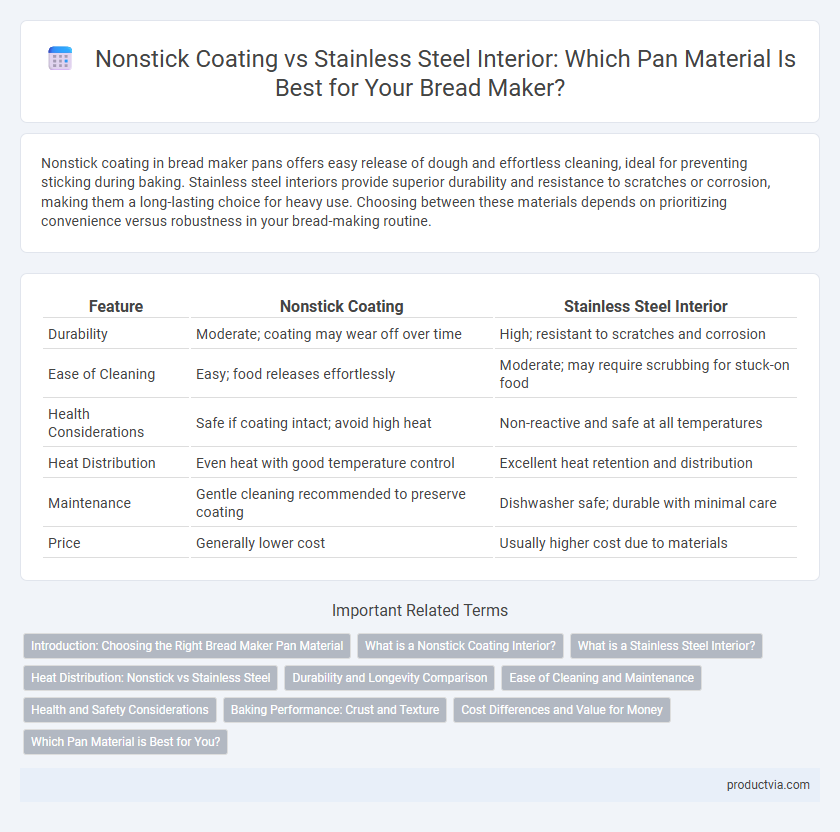Nonstick coating in bread maker pans offers easy release of dough and effortless cleaning, ideal for preventing sticking during baking. Stainless steel interiors provide superior durability and resistance to scratches or corrosion, making them a long-lasting choice for heavy use. Choosing between these materials depends on prioritizing convenience versus robustness in your bread-making routine.
Table of Comparison
| Feature | Nonstick Coating | Stainless Steel Interior |
|---|---|---|
| Durability | Moderate; coating may wear off over time | High; resistant to scratches and corrosion |
| Ease of Cleaning | Easy; food releases effortlessly | Moderate; may require scrubbing for stuck-on food |
| Health Considerations | Safe if coating intact; avoid high heat | Non-reactive and safe at all temperatures |
| Heat Distribution | Even heat with good temperature control | Excellent heat retention and distribution |
| Maintenance | Gentle cleaning recommended to preserve coating | Dishwasher safe; durable with minimal care |
| Price | Generally lower cost | Usually higher cost due to materials |
Introduction: Choosing the Right Bread Maker Pan Material
Nonstick coating in bread maker pans ensures easy release of bread and simplifies cleaning, making it ideal for users prioritizing convenience. Stainless steel interiors offer superior durability and resistance to scratches, providing a long-lasting, hygienic baking surface. Selecting between nonstick and stainless steel depends on the balance between ease of maintenance and material longevity.
What is a Nonstick Coating Interior?
A nonstick coating interior in a bread maker pan is typically made from materials like Teflon or ceramic that prevent dough from sticking during baking, ensuring easy removal and cleaning. This coating facilitates uniform heat distribution while minimizing the need for additional grease or flour, enhancing baking efficiency. Unlike stainless steel interiors, nonstick coatings require careful handling to avoid scratches that can compromise their performance and longevity.
What is a Stainless Steel Interior?
A stainless steel interior in a bread maker pan offers durability, resistance to rust, and easy cleaning without the risk of coating peeling. Unlike nonstick coatings, stainless steel surfaces do not degrade over time, ensuring consistent baking performance and healthier bread by avoiding chemical release. This material also provides even heat distribution, essential for uniform bread texture and crust development.
Heat Distribution: Nonstick vs Stainless Steel
Nonstick coating in bread maker pans offers even heat distribution, reducing hotspots and preventing bread from sticking for consistent baking results. Stainless steel interiors provide excellent durability and conduct heat quickly but may produce uneven heat distribution without a proper base design. Choosing between nonstick and stainless steel depends on the balance between heat performance and ease of cleaning for optimal bread making.
Durability and Longevity Comparison
Nonstick coating pans offer ease of cleaning and prevent dough from sticking but tend to wear down over time, reducing durability and requiring replacement every few years. Stainless steel interiors provide superior longevity as they resist scratches, corrosion, and staining, maintaining performance throughout extended use. For users prioritizing long-term investment and robust durability, stainless steel pans are the optimal choice in bread maker construction.
Ease of Cleaning and Maintenance
Nonstick coating in bread maker pans offers superior ease of cleaning by preventing dough and baked loaf residues from sticking, significantly reducing scrubbing time. Stainless steel interiors provide a durable, scratch-resistant surface but often require more effort to remove baked-on crumbs and oils, demanding thorough hand washing. Choosing nonstick pans enhances convenience for frequent users focused on quick maintenance, while stainless steel suits those prioritizing durability and long-term wear resistance.
Health and Safety Considerations
Nonstick coating bread maker pans often contain a layer of polytetrafluoroethylene (PTFE), which can degrade at high temperatures and release potentially harmful fumes, posing health risks. Stainless steel interiors offer a safer alternative by avoiding chemical coatings, providing a non-reactive surface that resists corrosion and eliminates concerns about toxic emissions. Choosing stainless steel improves food safety and ensures durability without compromising the health of users during the bread-making process.
Baking Performance: Crust and Texture
Nonstick coating in bread maker pans promotes even heat distribution, resulting in a consistently crisp crust and tender crumb texture, ideal for delicate breads. Stainless steel interiors offer superior heat retention and durability, producing a firmer crust and chewier texture favored in artisan-style loaves. Choosing between nonstick and stainless steel directly impacts the bread's crust quality and internal moisture balance during baking.
Cost Differences and Value for Money
Nonstick coating pans for bread makers generally cost less upfront, offering ease of cleaning and reduced risk of bread sticking, which enhances convenience for home bakers. Stainless steel interiors, while often more expensive, provide superior durability, resistance to scratches, and long-term value due to their longevity and ability to maintain consistent baking temperatures. Evaluating cost differences alongside baking frequency helps determine value for money, with stainless steel preferred for frequent use and nonstick favored for budget-conscious, occasional bakers.
Which Pan Material is Best for You?
Nonstick coating in bread maker pans ensures easy release of dough and effortless cleaning, ideal for beginners or frequent bakers seeking convenience. Stainless steel interiors provide superior durability, even heat distribution, and resistance to scratches, making them suitable for experienced users prioritizing longevity and robust performance. Choosing the best pan material depends on your baking frequency, maintenance preference, and desire for durability or ease of use.
Nonstick coating vs stainless steel interior for pan material Infographic

 productvia.com
productvia.com